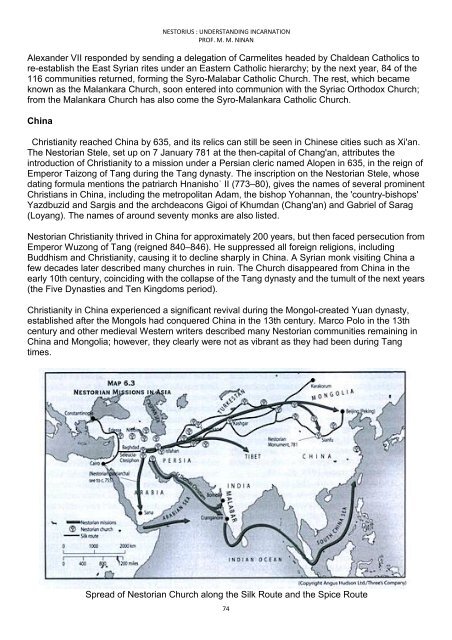Nestorius
Create successful ePaper yourself
Turn your PDF publications into a flip-book with our unique Google optimized e-Paper software.
NESTORIUS : UNDERSTANDING INCARNATION<br />
PROF. M. M. NINAN<br />
Alexander VII responded by sending a delegation of Carmelites headed by Chaldean Catholics to<br />
re-establish the East Syrian rites under an Eastern Catholic hierarchy; by the next year, 84 of the<br />
116 communities returned, forming the Syro-Malabar Catholic Church. The rest, which became<br />
known as the Malankara Church, soon entered into communion with the Syriac Orthodox Church;<br />
from the Malankara Church has also come the Syro-Malankara Catholic Church.<br />
China<br />
Christianity reached China by 635, and its relics can still be seen in Chinese cities such as Xi'an.<br />
The Nestorian Stele, set up on 7 January 781 at the then-capital of Chang'an, attributes the<br />
introduction of Christianity to a mission under a Persian cleric named Alopen in 635, in the reign of<br />
Emperor Taizong of Tang during the Tang dynasty. The inscription on the Nestorian Stele, whose<br />
dating formula mentions the patriarch Hnanishoʿ II (773–80), gives the names of several prominent<br />
Christians in China, including the metropolitan Adam, the bishop Yohannan, the 'country-bishops'<br />
Yazdbuzid and Sargis and the archdeacons Gigoi of Khumdan (Chang'an) and Gabriel of Sarag<br />
(Loyang). The names of around seventy monks are also listed.<br />
Nestorian Christianity thrived in China for approximately 200 years, but then faced persecution from<br />
Emperor Wuzong of Tang (reigned 840–846). He suppressed all foreign religions, including<br />
Buddhism and Christianity, causing it to decline sharply in China. A Syrian monk visiting China a<br />
few decades later described many churches in ruin. The Church disappeared from China in the<br />
early 10th century, coinciding with the collapse of the Tang dynasty and the tumult of the next years<br />
(the Five Dynasties and Ten Kingdoms period).<br />
Christianity in China experienced a significant revival during the Mongol-created Yuan dynasty,<br />
established after the Mongols had conquered China in the 13th century. Marco Polo in the 13th<br />
century and other medieval Western writers described many Nestorian communities remaining in<br />
China and Mongolia; however, they clearly were not as vibrant as they had been during Tang<br />
times.<br />
Spread of Nestorian Church along the Silk Route and the Spice Route<br />
74

















